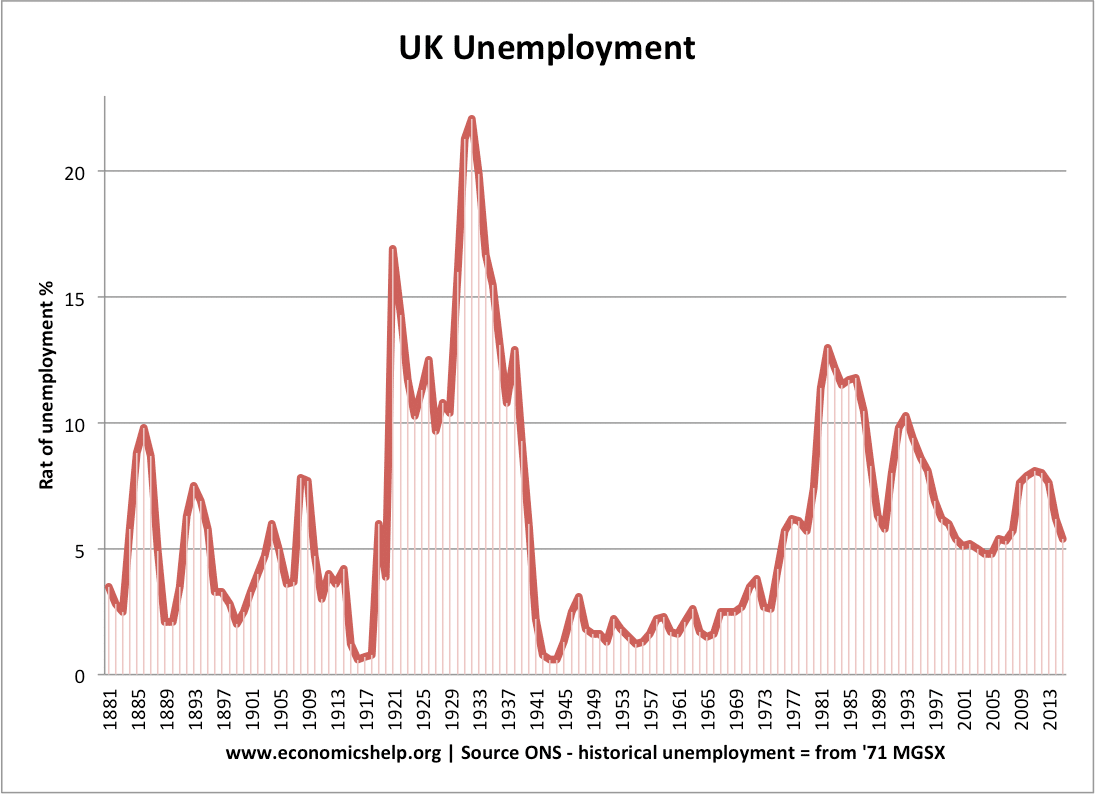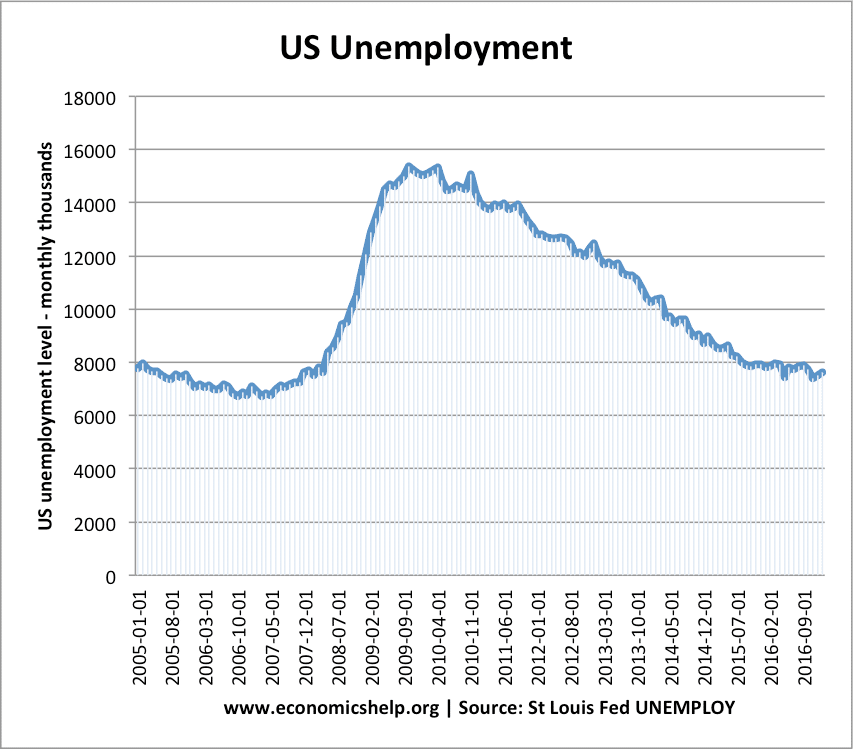Definition: Structural unemployment is caused by a mismatch of skills between the unemployed and available jobs. Structural unemployed is caused by changes in the economy, such as deindustrialisation, which leaves some unemployed workers unable to find work in new industries with different skill requirements.
Structural unemployment occurs even during periods of strong economic growth. It is a form of supply-side unemployment and not insufficient aggregate demand (AD). Policies to reduce structural unemployment include retraining and geographical subsidies. Fiscal or monetary policy to boost AD will be ineffective in solving structural unemployment.
Example of structural unemployment
The US car manufacturing firm (General Motors) closed down in Detroit due to strong international competition. Car workers become unemployed but were not qualified to gain jobs in areas of labour vacancies, such as teaching, doctors, electricians, IT – mostly in other parts of the country. Due to the decline of the car industry, in 2009, unemployment in Detroit rose to 29% (compared to the national rate of 9.8%) (link)
Causes of Structural unemployment
Geographical immobilities – This occurs when workers are unable to move from areas of high unemployment to areas with labour shortages. This could occur due to the difficulties of buying/renting a house. It could also be due to family attachments to their current area. For example, often there are vacancies in London but unemployment in outlying regions. However, it is difficult for the unemployed to leave the northeast and find a place to live in London.
Occupational immobilities. This occurs after changes in the economy, which lead to shifting demand for skilled labour. For example, if there is a closure of manufacturing firms, workers with skills for these types of jobs may struggle to relocate in new industries where very different skills are required (e.g. IT skills, teaching, accountancy). It takes time for people to retrain and older workers may feel it is too difficult.
Do globalisation and free trade cause structural unemployment?
Globalisation and free trade can lead to shifting patterns of manufacture and labour demand. In recent decades, many firms have shifted the manufacture of clothes from high wage, western economies to Asian economies, such as China, India and Bangladesh. This has caused a degree of structural unemployment for those who have lost jobs in Western industries.
Globalisation and free trade do create new opportunities. For example, as old industries have declined, new industries have emerged, such as higher tech manufacture, IT, computing, insurance, and internet based companies. However, these new industries may require a different skill set to previous manufacturing jobs, and it is this that can cause structural unemployment.
Example – Decline of coal mining jobs

The UK, like many other Western economies, have seen the number of jobs in coal mining fall dramatically in the past 100 years. From employing over 1 million miners in the 1920s, there are now fewer than 5,000. Coal miners are a group of workers susceptible to structural unemployment. As manual workers, they may have no formal qualifications and may have strong attachments to their mining town. However, when the mines close it can be difficult to find new jobs.
However, although structural unemployment has been a major problem in former mining towns, there are also signs of new industries and jobs being created in regions such as south Wales and south Yorkshire
Policies to overcome structural unemployment
Education/training. These training schemes need to be focused on skills and qualifications which will enable the unemployed to find work in new industries. This could include the government paying for training schemes in skills which are in short supply. For example, vocational training such as bricklaying/plumber/electrician or nursing.
- In a free market, firms may be unwilling to provide sufficient training because of the ‘free-rider problem’ If workers benefit from training schemes, they can then go and work for other firms. If the government pays the full cost or subsidises firms, it helps overcome this market failure.
- However, there may be a drawback of government failure. For example, a government department may be slow to respond to changing market preferences and subsidise the wrong kind of training schemes or those which employers don’t necessarily need. Also offering training schemes may not necessarily have a high take up rate. The unemployed may lack the confidence or willingness to take on new training schemes because they are unsure of their benefits.
Housing subsidies. With geographical unemployment, the government could offer housing benefits to help the unemployed take jobs in expensive areas of high employment.
- However, this could prove quite expensive, and it may be hard to evaluate who needs the housing benefits and for how long. A long term solution maybe for the government to build housing in expensive areas.
Employer subsidies. Rather than encourage workers to move, the government can offer incentives for firms to relocate to depressed areas. For example, the government have relocated many civil service jobs away from London and to areas of higher unemployment such as South Wales, Yorkshire and Scotland.
- However, there is a limit to how many jobs you can relocate to other regions. Employers will be reluctant to move from metropolitan cities like New York and London to struggling urban or rural areas, such as ‘rust belt’ in the US.
Labour market flexibility
Free market economists place greater stress on improving labour market flexibility. For example, allowing part-time, temporary work provides more opportunities for the unemployed to gain new opportunities.
- However, these jobs are more insecure, often lower paid and lead to a form of under-employment.
Problems of structural unemployment
Hysteresis – This is the idea that high rates of unemployment cause future unemployment rates to be higher. Workers unemployed for a long-time become less employable, even if they do get new qualifications.
Decline in the participation rate. Periods of high structural unemployment can cause a fall in participation rates. Workers become discouraged, demotivated and more likely to suffer health problems. Therefore, they may give up on the labour market and take early retirement or be classed as long-term sick. These former workers are no longer counted as unemployed, but they are a loss to the labour market and tend to be net recipients of government aid – health care and welfare benefits.
Alienation. Unemployment is associated with a variety of costs from economic to personal health issues. See costs of unemployment.
Ghost Towns. The decline in the Detroit US car industry and subsequent structural unemployment led to a decline in the population from 2 million to 900,000. Furthermore, the most skilled and mobile workers are the first to leave. Leaving pockets of poverty, drug use and other social problems.
UK structural unemployment

- This shows a rise in structural unemployment during the 1980s and 1990s
- However, the fall in UK unemployment rate 2010-16, suggests a lower rate of structural unemployment compared to the 1980s.
Economist perspectives on structural unemployment
Monetarists like Milton Friedman argue that unemployment is essentially a supply-side problem, and what is needed is labour market reforms (such as cutting minimum wages, cutting taxes) and making it easier for firms to set up business.
Joseph Schumpeter argued an essential feature of capitalism is the process of ‘creative destruction’ He argued it was necessary for old inefficient forms of business to close down. This enables new more efficient industries to take their place. He would argue it is wrong to try and hold back progress and keep one million miners forever digging coal. Some structural unemployment may be a side effect of economic progress, but it is a price worth paying.
Joseph Stiglitz argues that whilst free markets have a role to play, globalisation and free trade has often led to too many ‘losers.’ Despite gains in real GDP, some are left behind because of the rapid pace of economic change and lack of support for former manufacturing workers who become structurally unemployed.
Paul Krugman argues that some economists were guilty of claiming demand deficient unemployment was actually structural unemployment. In the aftermath of 2008/09 recession unemployment rose and free-market economists (who opposed the use of fiscal policy) argued this unemployment was due to structural factors (inefficiencies in labour market). However, the rapid fall in US unemployment was due to economic growth and decline of demand deficient unemployment. Krugman, P (2013) Structural humbug, NY Times.
Related issues
- The Luddite Fallacy – the argument new technology permanently destroys jobs
- Causes of unemployment


Extrapolating your way of thinking, the unenployment will end when the labor cost were zero, that is, when the slavery returns.
You should start to accept that your economic faith is dying.
If labor costs were truly zero (i.e., we could have whatever we want, immediately, and with no effort or pain on our part), no one would look to others to serve them, whether by hire or by enslavement.
Perhaps you should check your own economic faith?
I think the government are not doing enough. Surely to ensure the progress of a country, is to support people in personal and professional development, to aquire skills to enter employment. There are too many barriers, inc cost of studying. It makes me wonder if the high rate of people that the gov could not support, thus reform and brutal assessments is a result of gov failing in first place.
The benefit reform was not properly thought through in that courses/retraining could have been implemented before snatching financial support from people, some unable to work, some nowhere near ready. And all done
on
on incapacity benefit (on the sick), who were shamed through a programme pn benefits
I think we need to focus on the skills issue. I work in workforce development and we focus on getting people into training but at my level we just assume training leads to jobs when that is not always the case.
Hi, can anyone help me puzzle this out :
* Describes 5 types of structural unemployment in a country.